Kollegen!!!
I have an addiction: build similar kits in pairs, to save time and research ...
 |
| Sd.kfz.9 cargo and Sd.Kfz 9/1crane version towing a Tiger |
So, I'll show to you guys a couple of gorgeous German twins girls; Similar, but not identical ...
Uops...wrong pic... The correct is this Tamiya girl, in two versions, in double building: Schwerer Zugkraftwagen 18 t SdKfz 9 - FAMO.
 |
| Tamiya FAMO |
As I had two of these kits in my closet, I decided to build this pair at once (in 2010). But, first of all, let us know the history of this big lady.
History:
The Sd.Kfz. 9
Schwerer Zugkraftwagen (also known as "Famo" ) was a German half-track that saw widespread use in World War II, and the heaviest half-track vehicle of any type built in quantity in Nazi Germany during the war years. Its main roles were as a
prime mover for very heavy towed guns such as the
24 cm Kanone 3 and as a tank recovery vehicle. Approximately 2,500 were produced between 1938 and 1945.
 |
| Schwerer Zugkraftwagen (Heavy tractor)18 t SdKfz 9 - FAMO |
The Sd.Kfz. 9 had a ladder frame chassis. Power was provided by a
Maybach 12-cylinder, water-cooled, 10.838 litres (661.4 cu in) HL 108 gasoline engine of 270 horsepower (270 PS). It had a
syncromesh ZF G 65 VL 230 transmission with four forward and one reverse gears. It had two fuel tanks, one of 90 litres (24 US gal) and the other of 230 litres (61 US gal) capacity.
Both tracks and wheels were used for steering. The steering system was set up so that shallow turns used only the wheels, but brakes would be applied to the tracks the further the steering wheel was turned. The drive sprocket, like all German halftracks, had rollers rather than the more common teeth. The rear suspension consisted of six double sets of overlapping, interleaved roadwheels mounted on swing arms sprung by torsion bars. An idler wheel, mounted at the rear of the vehicle, was used to control track tension. The front wheels had leaf springs and shock absorbers.
The upper body had a crew compartment common to all versions. This had bench seats, one for the driver and his assistant, and another for the crew. The rear portion of the upper body was adapted for the vehicle's intended role. The artillery model had two extra bench seats for the gun's crew and space for its ammunition.
 |
| FAMO SdKfz 9 artillery version |
The cargo or towing version had just two storage compartments mounted in the front of the cargo compartment, one on each side, that opened to the outside.
 |
| FAMO SdKfz 9 towing version |
The windshield could fold forward and was also removable. A convertible canvas top was mounted at the upper part of the rear body. It fastened to the windshield when erected.
The Sd.Kfz. 9 was designed to have a towing capacity of 28 tonnes (28 long tons; 31 short tons). This was adequate for medium tanks like the
Panzer IV, but two or even three or four were necessary for heavier vehicles like the
Tiger I,
Panther or
King Tiger.
 |
| Two SdKfz 9 towing a Panther tank |
 |
| Two SdKfz 9 towing a Ferdinand/Elephan destroyer |
 |
| A Famo SdKfz 9 and a SdKfz 9/1 towing a Tiger tank |
It towed
Sd.Anh 116 low-loader trailers to carry disabled vehicles.
 |
| FAMO SdKfz 9 towing a Panzer III in a Sd. Anh. 116 trailer |
 |
| FAMO SdKfz 9 towing a Panzer III in a Sd. Anh. 116 trailer - rear view |
 |
| FAMO SdKfz 9 towing a captured Matilda II in a Sd. Anh. 116 trailer |
Preliminary design of all the German half-tracks of the early part of the war was done by Dipl.Ing. Ernst Kniepkamp of the Military Automotive Department (Wa Prüf 6) before the Nazis took power in 1933. His designs were then turned over to commercial firms for development and testing. Fahrzeug- und Motorenbau GmbH (
FAMO) of
Breslau received the contract for the 18 t (18 long tons; 20 short tons) heavy towing tracked vehicle. Their first prototype, the FM gr 1, was completed in 1936. It had a 200 horsepower (200 PS)
Maybach HL 98 TUK engine and was only 7.7 metres long. The F 2 prototype appeared in 1938, but differed only in detail from its predecessor.
The F 3 appeared in 1939 and was the production version. The design was simplified over the course of the war to reduce costs and the use of strategic metals. Some vehicles produced by Tatra had its 12-cylinder, air-cooled Type 103 diesel engine fitted. Large spades were added at the rear of the chassis during the war to improve the vehicle's ability to recover tanks and other heavy vehicles.
A new upper body was used for the Sd.Kfz. 9/1 which mounted a 6 t (5.9 long tons; 6.6 short tons) capacity crane in lieu of the crew's bench seat and the cargo compartment. It was issued to tank maintenance units beginning in September 1941.
 |
| SdKfz 9/1 6 ton. crane in action |
A larger, gasoline-electric, 10 t (9.8 long tons; 11 short tons) crane was fitted on the laterSd.Kfz. 9/2, but this required outriggers to stabilize the vehicle before operations could begin.
 |
| Sd.Kfz. 9/2 lifting a Tiger turret |
In 1942, was placed order for 112 self propelled
8.8cm Flak 37. The first prototype vehicle was completed at the end of October 1942. From July to September 1943, a total of 12 production vehicles 8.8cm Flak 37 (Sf.) auf s. Zgkw. 18t - a self propelled 8.8cm anti aircraft gun - were produced. The armoured upper body was 14.5mm thick armour riveted plates. The gun itself had limited traverse because of the armored cab and could only be fully traversed with the gun elevated. A platform with drop-down sides was fitted for the gun. During combat, these stabilizing legs had to be folded down for reasons of stability. The vehicle weighed 25 tonnes, was 9.32 metres long, 3.67 metres tall and 2.65 metres wide. 40 rounds could be stored in ammo boxes at the rear. Due to the increased weight of the vehicle, the chassis had to be strengthened.
All 12 serial vehicles were assigned to Heeres-Flak-Abteilung 304 of 26. Panzer Division. They were used in Italy from 1943 to 1945.
 |
FAMO 8.8cm Flak 37 Selbstfahrlafette auf 18 ton Zugkraftwagen
in AA firing position |
 |
| FAMO 8.8cm Flak 37 Selbstfahrlafette auf 18 ton Zugkraftwagen in firing AT position |
Vomag of
Plauen began producing the Sd.Kfz. 9 in 1940 and
Tatra joined in the last years of the war. 855 were on hand on 20 December 1942. 643 were built in 1943 and 834 in 1944. Approximately 2,500 were built in total.
| Sd.Kfz. 9 |
|---|
|
| Type | Heavy half-track |
|---|
| Place of origin | Nazi Germany |
|---|
| Service history |
|---|
| In service | 1938–55? |
|---|
| Used by | Nazi Germany
Romania |
|---|
| Wars | World War II |
|---|
| Production history |
|---|
| Designer | FAMO |
|---|
| Designed | 1936–39 |
|---|
| Manufacturer | FAMO, Vomag, Tatra |
|---|
| Produced | 1939–45 |
|---|
| Number built | approx. 2500 |
|---|
| Variants | Sd.Kfz. 9/1, Sd.Kfz. 9/2 |
|---|
| Specifications |
|---|
| Weight | 18,000 Kg |
|---|
| Length | 8.32 metres |
|---|
| Width | 2.6 metres |
|---|
| Height | 2.85 metres (overall) |
|---|
| Crew | depends on body type fitted |
|---|
|
| Engine | 10.8L Maybach HL 108 petrol, 12-cylinder, water-cooled
270 horsepower (270 PS) |
|---|
| Payload capacity | 2,620 Kg |
|---|
| Transmission | 4 + 1 speed ZF G 65 VL 230 |
|---|
| Suspension | torsion bar |
|---|
| Ground clearance | 44 centimetres |
|---|
| Fuel capacity | 290 litres |
|---|
Operational
range | 260 kilometres (road)
100 kilometres (cross-country) |
|---|
| Speed | 50 km/h (road) |
|---|
The kits:
As I say, to do this double project, I used two FAMOs from Tamiya. Old kits, but very good and easy to build. My idea was to use a Bilstein crane in resin, which had built years ago and that was leaning in a corner of my workshop, waiting for the right carrier ...The other FAMO would be a cargo version.
 |
| Bilstein 6 ton. crane - resin - Panzerserra's kit. |
For the crane version, I had to transform the kit Tamiya through plastic surgery. There are conversion kits on the market, but I like doing things on scratch ... It's part of the fun! This picture below was my inspiration. Notice the crane's base (rigid) and a toolbox in the rear of the loading platform. These are characteristics of the early versions of the SdKfz 9/1.
 |
| SdKfz 9/1 - early version |
The later versions had a joint at the base of the crane and did not bear the toolbox in the aft.
 |
| SdKfz 9/1 - late version |
Well, starting the fun...Engines: As I would leave the engines exposed, I sweat in the detailing and painting
 |
| Gentleman, start your engines.... |
 |
| engines and transmissions in colors |
 |
| The two chassis... |
 |
| ..with the engines( dry-run)!! |
Painting the chassis in Panzer-gray:
 |
| chassis painted |
While the chassis paint dries, I was taking care of the wheels ... So many!!
 |
| Wheels in barbecue sticks, for painting.... |
 |
| Painting the wheels... |
 |
| drying... |
 |
| drying... |
 |
| ...and in the suspensions!!! |
 |
| front wheels |
 |
| front suspensions and axles... |
 |
| ready to build... |
 |
| The front wheels and reels winch of the chassis: |
 |
| engine and transmission: starting the weathering... |
 |
| close-up |
 |
| Used !!! |
 |
| Notice the chassis winches |
For now, the building of the girls are in parallel ... soon, they will differentiate.
 |
| The snouts of the FAMOs... |
And now, the buildings will differentiate enough. Notice the differences between the tractor version and crane version.
 |
| observe the red arrows ... all this will be removed and the side, cut |
 |
| surgery in the crane version |
The cabin's floor of the crane version with details already removed:
 |
| details already removed: green arrows |
 |
| crane and tractor...side by side. |
 |
| cabin's sides of the crane version: surgery done !!!! |
And the cabins built ... Compare the two girls:
 |
| The two cabins..Notice the differences!!! |
In the crane version, I cut the back part of the cabin, just to seize the support of the cab in the chassis. I cut in the green arrows and discarded the part in scratched red.
 |
| I used only the lower portion of the part |
 |
| After cutting, testing the cabin's support in the chassi |
 |
| belly view - no differences!!! |
And the front view of the cabins:
As the sides of the hoods will be opened, parts of firewalls should be seen. Details made with copper wire and pieces of my scrap box.
 |
| details with scrap parts. |
 |
| the two cabins |
 |
| with panzer-gray... |
 |
| dry-run with snouts... |
 |
| making the steel cables of the chassis winches |
 |
| ..and building the cabins in the chassis... |
 |
| The tractor version... |
 |
| Using telephone wiring to transform the air filters hoses |
 |
| the radiator rods in metal... |
 |
| ...and painted in panzer-gray |
 |
| the steel cables... |
 |
| ..done!! |
The radiators dont have hoses !!!!
To build the radiator hoses, I used the plastic isolation of the eletric wires
 |
| stripping the wires to use the isolators ... |
Very good, indeed!!!
 |
| hoses in place... |
Between the hood and the firewall is a gap in the original vehicle. This gap is filled with a tarp. I simulated this canvas with putty softened in thinner
 |
| mmaking canvas with putty |














































































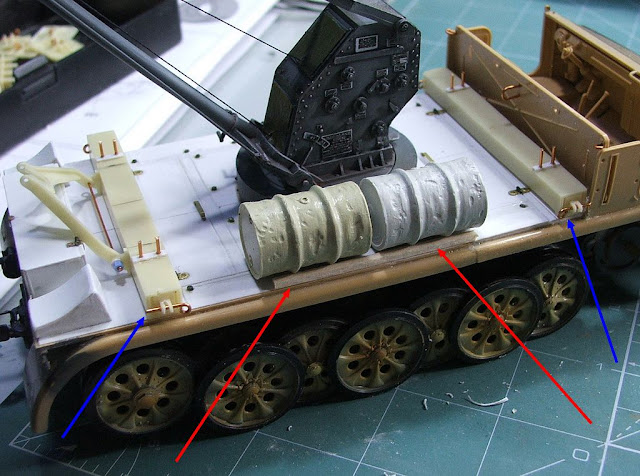

















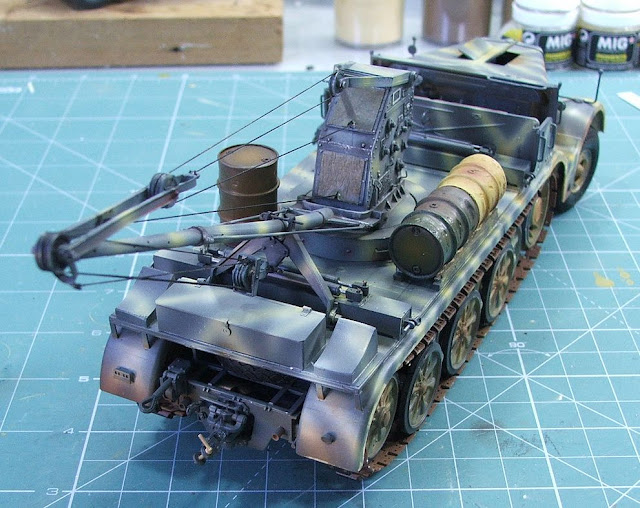














































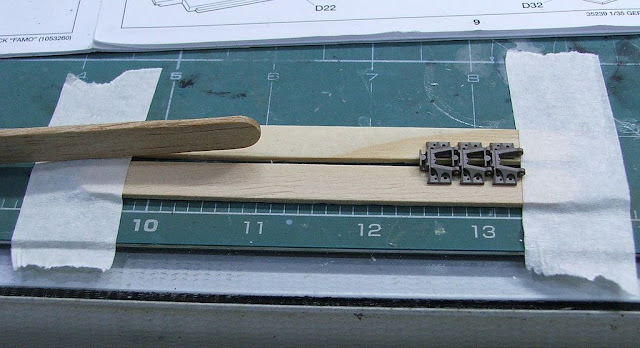








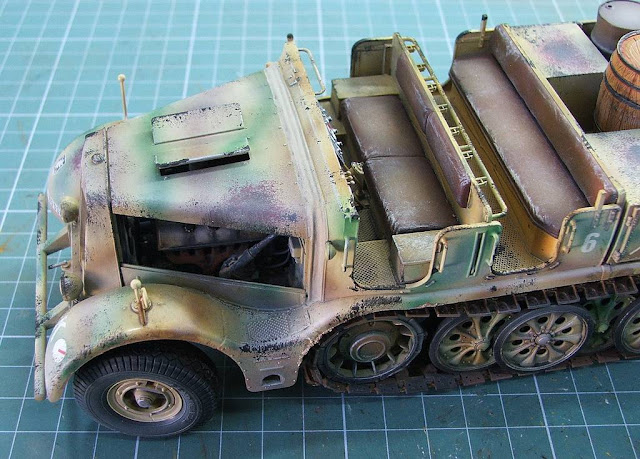
























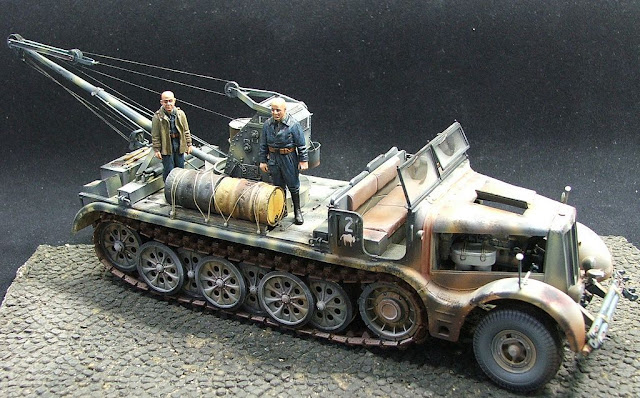


Hi Panzer,
ResponderExcluirthis is an astonishing build - I really love your Blog, I have been following this for a year or so now, but the Twin FAMOs top everything I have seen so far. I am really, really looking forward to seeing more of your builds, keep it up, take care and all the best to you!
Mason
Thanks, Grendel...thanks for your courtesy and incentive.
ResponderExcluirGood hunt and take care....
A big Wow , and Amazing post. Great review. Keep up the good work.
ResponderExcluirLifting Chains
Thanks, Marina.
ResponderExcluirBig hug and cheers !!!
Serra parabéns pela iniciativa, eu tenho o FAMO F3 já montado. A foto dele neste artigo elucidou-me dando condição de decidir qual o envelhecimento dele. Obrigado! Como sabe, eu faço militaria Brasileira porem, o tamanho e o volume de peças deste kit faz a gente se mexer.
ResponderExcluirParabéns,
Fernando Silveira
José Fernando...muito obrigado!! Que bom que o artigo te ajudou. Um grande abraço e o Bunker é nosso...sempre que precisar, nos visite e escreva!!!
ExcluirGreat work and an inspiration, great detail, I will use it as a study on my !/16 RC version! Thanks!
ResponderExcluirAvatt, thanks for your incentive!!! Happy to have been able to help !!! Hugs, my friend!!
ExcluirGreat details
ResponderExcluirThanks a lot, Frybread!! Big hugs!!
ExcluirHi Brilliant work but one comment about accuracy. I don't believe the Germans made a solo motorbike during the 2nd World War also the sidecars on the Zundap and the BMW couldn't be removed successfully as their sidecars wheel was driven.
ResponderExcluirCheers
Unknown ... thank you very much for the compliments ...
ExcluirRegarding the veracity of the existence of bikes without a sidecar, if you search a little more deeply, you will find many, but many pictures of "solo" bikes, without the sidecar. And the wheels of the sidecars generally had no traction, but they were free ... Except for the Zundapp KS 750, but there were the Zundapp 750 solo. I attached some pictures of Zundapp and BMW Motorbikes without sidecar in the construction text above, as an illustration. Never say never when it comes to WWII ... and never say always !!! A big hug!!
Nao havia visto ainda Serra... Como sempre, ducarai... e legal que tem as fotos das motos...eu sempre tive essa duvida tbm. Pensei que fosse a construção recente do trailer... ate estranhei a velocidade com que ficou pronto.. mas nao eh o mesmo rsrsrrsrs. Abs
ResponderExcluirOi Marcão... que bom te ver por aqui, mais uma vez... Realmente, nem todas as motos eram "traçadas" com o side car...E é bom a gente matar a cobra e mostrar o pau!!! Eu vou terminar o outro it logo...dei uma parada para uma das minhas loucuras prediletas, que são os protótipos...e no caso do t31, faziam anos que eu estava atrás desse it de conversão... Um grande abraço e a casa é sua, como sempre...
Excluir